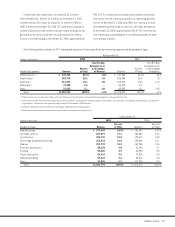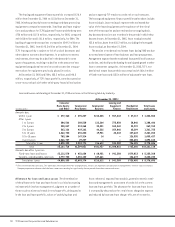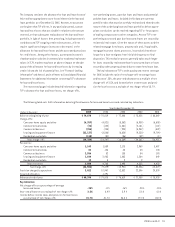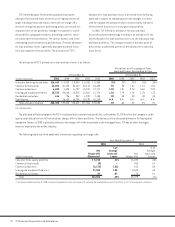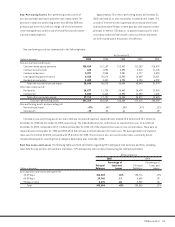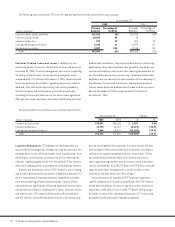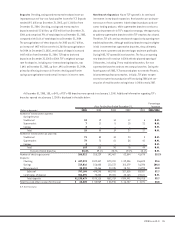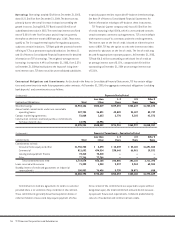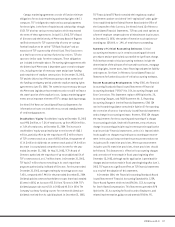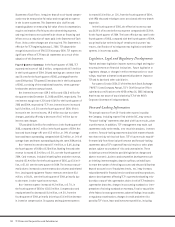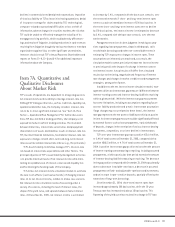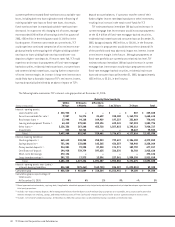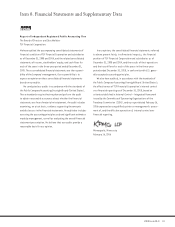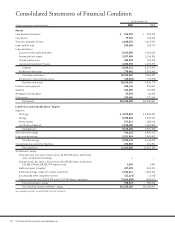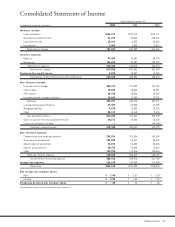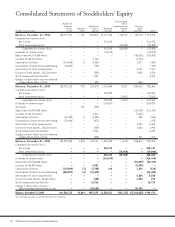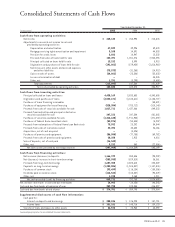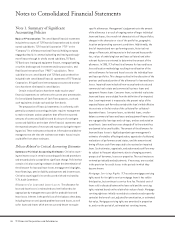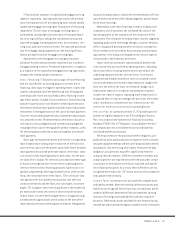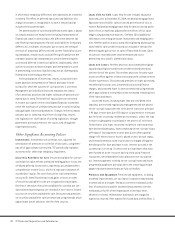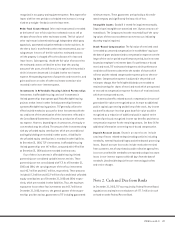TCF Bank 2005 Annual Report Download - page 59
Download and view the complete annual report
Please find page 59 of the 2005 TCF Bank annual report below. You can navigate through the pages in the report by either clicking on the pages listed below, or by using the keyword search tool below to find specific information within the annual report.
392005 Form 10-K
declines in commercial or residential real estate values; imposition
of vicarious liability on TCF as lessor in its leasing operations; denial
of insurance coverage for claims made by TCF; technological,
computer-related or operational difficulties or loss or theft of
information; adverse changes in securities markets; the risk that
TCF could be unable to effectively manage the volatility of its
mortgage servicing portfolio, which could adversely affect earn-
ings; and results of litigation, including reductions in card revenues
resulting from litigation brought by various merchants or merchant
organizations against Visa; or other significant uncertainties.
Investors should consult TCF’s Annual Report to Shareholders and
reports on Forms 10-K, 10-Q and 8-K for additional important
information about the Company.
Item 7A. Quantitative and
Qualitative Disclosures
About Market Risk
TCF’s results of operations are dependent to a large degree on its
net interest income and its ability to manage interest-rate risk.
Although TCF manages other risks, such as credit risk, liquidity risk,
operational and other risks, the Company considers interest-rate
risk to be its most significant market risk. See “Item 1A. Risk
Factors – Operational Risk Management” for further discussion.
Since TCF does not hold a trading portfolio, the Company is not
exposed to market risk from trading activities. The mismatch
between maturities, interest rate sensitivities and prepayment
characteristics of assets and liabilities results in interest-rate risk.
TCF, like most financial institutions, has material interest-rate risk
exposure to changes in both short-term and long-term interest
rates as well as variable interest rate indices (e.g., the prime rate).
TCF’s Asset/Liability Committee manages TCF’s interest-rate
risk based on interest rate expectations and other factors. The
principal objective of TCF’s asset/liability management activities
is to provide maximum levels of net interest income while main-
taining acceptable levels of interest-rate risk and liquidity risk
and facilitating the funding needs of the Company.
TCF utilizes net interest income simulation models to estimate
the near-term effects (next twelve months) of changing interest
rates on its net interest income, relative to a base case scenario.
Net interest income simulation involves forecasting under a
variety of scenarios, including the level of interest rates, the
shape of the yield curve, and spreads between market interest
rates. At December 31, 2005, net interest income is estimated
to increase by 1.4%, compared with the base case scenario, over
the next twelve months if short- and long-term interest rates
were to sustain an immediate increase of 100 basis points. In
the event short- and long-term interest rates were to decline
by 100 basis points, net interest income is estimated to decrease
by 2.4%, compared with the base case scenario, over the next
twelve months.
Management exercises its best judgment in making assump-
tions regarding loan prepayments, deposit withdrawals, calls
on wholesale borrowings and other non-controllable events in
estimating TCF’s exposure to changes in interest rates. These
assumptions are inherently uncertain and, as a result, the
simulation models cannot precisely estimate net interest income
or precisely predict the impact of a change in interest rates on
net interest income. Actual results will differ from simulated
results due to the timing, magnitude and frequency of interest
rate changes and changes in market conditions and management
strategies, among other factors.
In addition to the net interest income simulation model, man-
agement utilizes an interest rate gap measure (difference between
interest-earning assets and interest-bearing liabilities repricing
within a given period). While the interest rate gap measurement
has some limitations, including no assumptions regarding future
asset or liability production and a static interest rate assumption
(large changes may occur related to these items), the interest
rate gap represents the net asset or liability sensitivity at a point
in time. An interest rate gap measure could be significantly affected
by external factors such as loan prepayments, early withdrawals
of deposits, changes in the correlation of various interest-bearing
instruments, competition, or a rise or decline in interest rates.
TCF’s one-year interest rate gap was a positive $318.4 million,
or 2.4% of total assets at December 31, 2005, compared with a
positive $585.3 million, or 4.7% of total assets at December 31,
2004. A positive interest rate gap position exists when the amount
of interest-earning assets maturing or repricing, including assumed
prepayments, within a particular time period exceeds the amount
of interest-bearing liabilities maturing or repricing. The decrease
in the gap position compared with December 31, 2004 was primarily
due to a decrease in variable-rate loans, a decrease in assumed
prepayments on fixed- and adjustable-rate loans and investments,
and an increase in rate-sensitive deposits, partially offset by the
extensions of long-term borrowings.
Since December 31, 2004, short-term interest rates have
increased approximately 200 basis points, while the 10-year
Treasury rate has increased only about 15 basis points. This
flattening of the yield curve has resulted in a change in TCF loan


